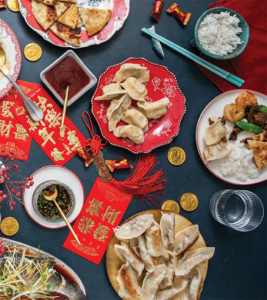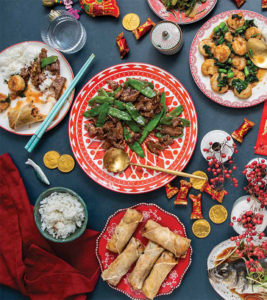Good Luck: Chinese Lunar New Year

The customs associated with the Chinese New Year (also known as the Spring Festival) are steeped in tradition and meant to usher in prosperity and good luck. Homes are festooned with red, streets are alive with firecrackers, and family meals are filled with dishes representing good fortune.
Abi Liu, head coach of the Bellevue Club Swim Team, grew up in southern China, where a whole fish is served on New Year’s Eve. “For me, it’s about the emotions attached to the night. It’s a big family gathering and there’s food—lots and lots of food,” says Abi. In northern China, dumplings are the traditional food at New Year. The whole family pitches in to fill, pinch, and boil dumplings before devouring them at midnight.
 Local cookbook author Hsiao-Ching Chou and her 17-year-old daughter, Meilee Chou Riddle, have just released “Feasts of Good Fortune: 75 Recipes for a Year of Chinese American Celebrations, from Lunar New Year to Mid-Autumn Festival and Beyond.” Their recipe for Pork and Chinese Cabbage Dumplings is worth the effort for an authentic taste of this lucky dish.
Local cookbook author Hsiao-Ching Chou and her 17-year-old daughter, Meilee Chou Riddle, have just released “Feasts of Good Fortune: 75 Recipes for a Year of Chinese American Celebrations, from Lunar New Year to Mid-Autumn Festival and Beyond.” Their recipe for Pork and Chinese Cabbage Dumplings is worth the effort for an authentic taste of this lucky dish.
Pork and Chinese Cabbage Dumplings
Makes about 48 dumplings
For the Dough:
2½ cups unbleached all-purpose flour, plus more for dusting
¾ cup warm tap water
For the Filling:
1 pound ground pork, preferably Kurobuta pork (or another type that’s not too lean)
2½ cups loosely packed finely chopped Chinese cabbage
1 green onion, finely chopped
2 tablespoons soy sauce
1 teaspoon minced fresh ginger
1 teaspoon sesame oil
¼ teaspoon white pepper powder
Your favorite dumpling dipping sauce
• To make the dough, place the flour in a large mixing bowl. Add the water and, using a rubber spatula or wooden spoon, stir the water and flour together. Continue to stir gently until a ball of dough starts to form.
• Start kneading the dough to make a ball. The dough should feel slightly tacky but not damp. Cover the dough with a damp towel or plastic wrap, and let it rest for a minimum of 20 minutes.
•To make the filling, combine the ground pork, Chinese cabbage, green onions, soy sauce, ginger, sesame oil, and white pepper in a medium bowl and mix well. Set aside.
• To make the wrappers, divide the dough in half. Roll each half into a rope that’s about ¾ inch in diameter and about 18 inches or so in length. Cut each rope into pieces that are about ¾ inch thick (or 9 or 10 grams). Dust your work surface and the dough pieces with flour. Roll each piece into a ball, then press it between your palms into a silver-dollar-size disk. With a 10- or 12-inch Chinese dowel-style rolling pin (available in Asian markets or online), roll each disk into a flat circle about 3 inches in diameter. Dust with flour as needed to prevent sticking. Don’t worry about making a perfect circle.
•Place a dollop of filling, about a teaspoon or so, into the center of a wrapper. Fold the round wrapper in half over the center into a half-moon shape and pinch shut along the edges. The dough should be just sticky enough to seal without using water or egg. Repeat until you have used up all the dough or you run out of filling.
• To cook, fill a large soup pot with 4 quarts of water and bring to a boil over high heat. Set a 1-cup measuring cup filled with cold water next to the stove, within easy reach. When the water starts to boil, carefully add about half the prepared dumplings, or only as many as your pot can accommodate without overcrowding. Return to a boil and cook for about 5 minutes. You may have to fish out a dumpling and cut it open to confirm. Keep a close watch on the water as it will likely bubble over. Add a quick splash of the cold water to help calm down the boil and adjust the heat as needed. You want a steady boil that doesn’t boil over the top of the pot.
The dumplings are done when they puff up and float, and the skins are slightly translucent. Use a large, slotted spoon or a spider strainer to transfer the cooked dumplings to a platter. Serve with your favorite dumpling dipping sauce.

Steamed Ginger-Scallion Branzino
Makes 4 to 6 servings, family style
Ingredients
6 green onions, cut into 3-inch julienne
½ cup very finely julienned fresh ginger, divided
1 whole branzino, about 1½ pounds (ask the fish butcher to clean and scale the fish)
1 to 2 teaspoons kosher salt
3 tablespoons soy sauce
2 tablespoons Shaoxing wine or a dry white wine (optional)
2 tablespoons vegetable oil
Roughly chopped fresh cilantro leaves (about ½ cup)
• Set up your steamer over medium heat. In a medium bowl, mix the green onions and ginger. Put half the mixture in another bowl. Set aside.
• Score the fish by gently making three or four cuts along the body from the dorsal fin to the belly. Your knife should graze the bone but not cut through it. Repeat on the other side. If you have two fish, repeat these steps for the second fish.
• Line a steam-proof dish with a piece of parchment paper, cutting the parchment to size as needed. After steaming, the parchment will help you transfer the fish to your serving platter. (If you have a larger steamer, you could use a glass pie plate, for example.) Place the fish on the parchment-lined dish. Carefully sprinkle some salt into the slits. Using half the ginger-onion mixture, place a few strands of ginger and onion in all the slits on both sides. Carefully lift the lid of the steamer, making sure to position yourself away from the burst of steam that will rise. Place the fish in the steamer, cover, and let steam for about 15 minutes.
• Meanwhile, combine the remaining ginger and onions with the soy sauce, wine, and vegetable oil in a small pot. Heat over medium-high heat. Once it comes to a boil, reduce the heat to low. Keep the sauce over low heat while the fish steams.
• Once the 15 minutes are up, check the fish for doneness: Turn off the heat and carefully lift the lid of the steamer and set aside. Using the tip of a sharp knife, gently probe the flesh at the thickest part of the fish. If it is opaque and flakes, it’s done. If it looks underdone, then replace the lid, turn the heat to high and steam for an additional 5 minutes.
• When done, take the dish out of the steamer and set it on a heatproof surface. Place your serving platter next to the fish. Using the parchment, lift the fish out of the steamer dish and place on the serving platter. Shimmy the parchment out from under the fish. Then pour the sauce mixture evenly over the fish. Garnish with cilantro and serve.


